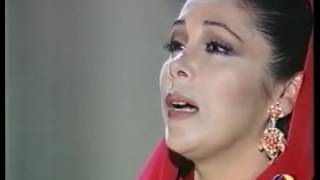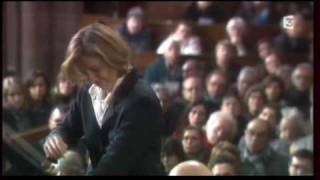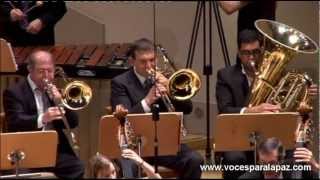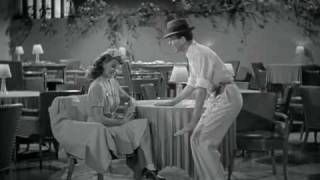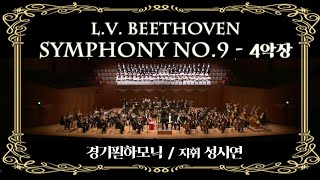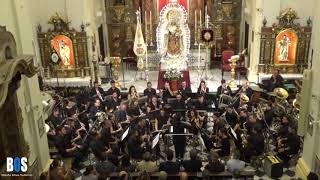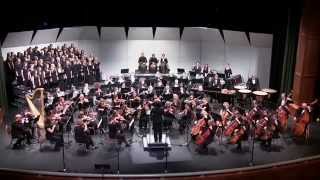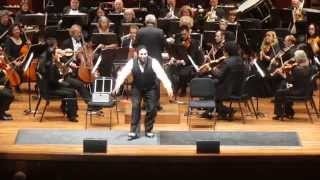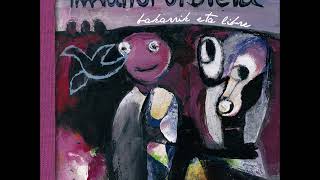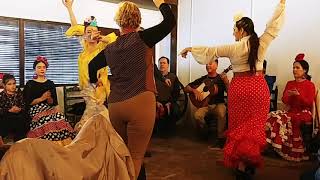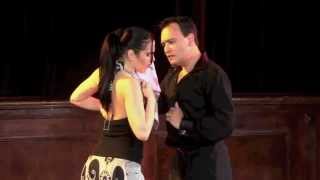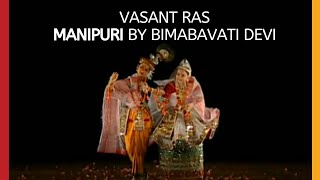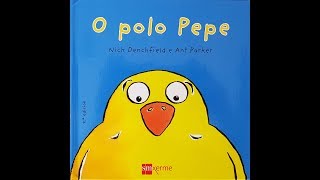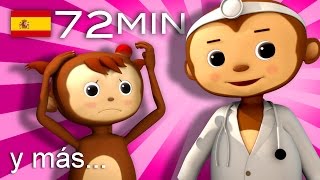From May 19 to 20, the Rocío Pilgrimage is celebrated
Africa Day is celebrated annually on May 25
May 25, International Tap Day.
Recommended music videos for initiation to classical music
The Pilgrimage of El Rocío —popularly called El Rocío —is a popular and religious celebration in honor of the Virgen del Rocío , which takes place in May or June, at the time of Pentecost . It was classified in 1965 as a Festival of National Tourist Interest and in 1980 as a Festival of International Tourist Interest and has experienced great growth since the mid -20th century . During the festival, hundreds of thousands of devotees and tourists gather in the village of El Rocío de Almonte , province of Huelva , in a festival that combines religious, folkloric, environmental and recreational character.
The Pilgrimage begins on Saturday with the recitation of the Holy Rosary . On the night from Sunday to Monday is the peak of collective fervor. It is when the Virgin is reunited with her faithful in the procession that begins with the spectacular “jump over the fence.” To the shouts of “ Long live Blanca Paloma! ”, the Virgin processions and staggers with the first light of dawn. The celebration ends when the Virgin enters her Hermitage again, on Monday morning, entrusting herself to the White Dove until the following year. The Virgin of Rocío is popularly known as the " White Dove " in reference to the Feast of Pentecost , when the Holy Spirit visited the Virgin and the Apostles in the form of a dove.
Manuel Pareja-Obregón (1933-1995) was a Sevillian musician and composer. Among his compositions, the Sevillanas and the fandangos from Huelva stand out, having participated in the introduction of Andalusian popular music into mass culture, introducing orchestral arrangements where previously only the guitar and drumsticks sounded. He was the author of some 3,000 works for a large group of famous artists on the Spanish stage; In 1987 he founded the school of drummers in the village of El Rocío, later known as the Tamborileros de Nuestra Señora del Rocío . He died in Seville at the age of 62 due to leukemia that had kept him in the hospital for the last two months of his life. He was cremated and his ashes scattered in the village of El Rocío .
The Salve Rociera is the salve that is sung to La Virgen del Rocío , in the Sanctuary of El Rocío in Almonte (Huelva). El Rocío , as the whole pilgrimage is traditionally called, is a phenomenon between religious and folkloric, which moves more than a million people on the days of celebration in the month of May or June (according to the variable festival of Pentecost ). who come to the hermitage to venerate the Virgin. It was precisely for the Pilgrimage of El Rocío , the Salve Rociera that Manuel Pareja-Obregón composed, also known as Salve a la Virgen del Rocío or Salve del olé , with lyrics by Rafael de León.
Today it is offered to us by the popular Isabel Pantoja .
Johann Pachelbel (1653-1706) was a prominent German composer, harpsichordist and organist of the Baroque period. He is among the most important musicians of the generation before Johann Sebastian Bach , whose father he was a friend. In addition to composing a large number of sacred and secular works, he contributed to the development of the chorale prelude and fugue, earning him a place among the most important composers of the Baroque era. Pachelbel 's music was very popular in his time, thanks to which he gained many students and managed to become a model for composers in southern and central Germany . Pachelbel favored a lucid and uncomplicated style, placing special emphasis on melodic and harmonic clarity.
The Canon in D major is Pachelbel 's best-known work and was the only canon he wrote, although, in reality, the term is relatively inaccurate because the piece is not strictly a canon but, rather, a chaconne or passacaille . Today the work is very popular and has been the subject of numerous versions and recordings.
Laurence Equilbey (1962) is a French director who studied in Paris and Vienna with Eric Ericson and Nikolaus Harnoncourt , among other teachers. Founder of the Accentus Choir and specialist in choral repertoire, she has conducted various European orchestras and published an extensive discography.
John Williams (1932) is an American composer, conductor, pianist and trombonist, considered one of the most prolific composers of soundtracks in the history of cinema; He has composed some of the most famous and recognizable of all time such as: Star Wars, Harry Potter, Jaws, ''Catch Me If You Can''. ET, Superman, Indiana Jones, Jurassic Park, Schindler's List, Home Alone and others. He has also made musical compositions for various Olympic Games , numerous television series, newscasts and several concert works . He has won the Oscar five times and has 52 nominations to his credit, establishing him as the second man with the most nominations for the highest award in the cinema after Walt Disney .
Dry Your Tears, Áfrika is the song from the soundtrack of the film Amistad , a film directed by Steven Spielberg and released in 1997, whose plot is based on the true story of a group of mutinous African slaves. on their trip from Sierra Leone to Cuba , aboard the ship La Amistad near Puerto Rico or in July 1839. The film extends from that date until the year 1841 in which they are declared free and are given the option of stay in the USA as free citizens or return to your country.
Tap , also called Tap , is an American style of dance, in which the feet move rhythmically while a musical tap is performed. It originates from the fusion of the clog dances of Ireland , northern England and Scotland , combined with the dances practiced by African Americans. Indeed; In 1739, black slaves were prohibited from using percussion instruments ; This motivated them to make the rhythms with their feet and hands. The dancers gathered to compete and to demonstrate their best qualities and movements. In this way a new dance was born: American tap . The dancers relaxed the rigid Irish postures, used arms and shoulders to mark and new steps were added; since improvisation was the essence of this dance.
Recommended classical music videos
Ludwig van Beethoven (1770-1827) together with Bach and Mozart is part of the trio of giants of Western music. Born in Bonn , his father, of Flemish origin, tried to showcase him as a second Mozart, although it was a notable failure. Despite this, from the age of nine the organist Christian Gottlob Neefe captivated him with the study of Bach , whom he would always keep in mind. In 1787 he moved to Vienna with the intention of taking Mozart classes, but the death of his mother returned him to Bonn a few days later. And so after five years, he returned to Vienna where he was able to study with Haydn and Salieri . However, his profession as an excellent pianist could not be carried out due to deafness that attacked him the following year, leaving him completely incapable of this faculty.
The catalog of Beethoven's works . There are 138 musical works composed by Beethoven , arranged by numbers known as opus (“work” in Latin) or its abbreviation op. , assigned by the composer's publishers while he was alive. On the sidelines, there are another 205 works that do not have an opus number and that were published after the composer's death. These works were assigned WoO numbers (Werke ohne Opuszahl, "works without opus number"). This catalog was first produced by Georg Kinsky and Hans Halm (Das Werk Beethovens) in 1955.
Symphony No. 9 in D minor, Op. 125, also known as "Coral", is the last complete symphony by the German composer Ludwig van Beethoven . It is one of the most transcendental, important and popular works of music and art. The last movement caused astonishment in its time by the incorporation of a quartet of vocal soloists and mixed choir, something unprecedented at that time; movement, on the other hand, that has become a symbol of freedom. In 2001, the original score of the symphony was inscribed in UNESCO's Memory of the World Register where it forms part, along with other outstanding monuments, of humanity's spiritual heritage.
Today we offer the fourth movement conducted by the Korean teacher Shi-Yeon Sung .
Joaquín Turina (1882-1949) was a pianist, composer and conductor born in Seville and author of the most relevant works of Spanish Impressionism along with Falla and Albéniz . Since he was a child, considered a “prodigy,” he improvised virtuously on the accordion; Although he began his piano studies at the same time as high school, in 1903 his parents died and he moved to Paris where he studied composition with Vincent D'Indy , earning a living with his piano performances. In 1913, when the First World War broke out, he returned to Madrid where he permanently established his residence. He was named full academician of the Royal Academy of Fine Arts of San Fernando , Favorite Son of Seville, in addition to receiving other important awards such as the Grand Cross of Alfonso X the Wise .
The Rocío Procession , which we present today, is a symphonic poem composed by Joaquín Turina in 1912 in Paris . The piece was premiered on March 30, 1913 at the Teatro Real in Madrid by Enrique Fernández Arbós , dedicatee of the work, conducting the Madrid Symphony Orchestra . There is a version for piano made by the composer between June 6 and 10, 1913. This symphonic poem is inspired by the religious tradition that takes place every year in the Aldea del Rocío (Almonte, Huelva), in which the The image of the Virgin is processed through the village as part of the Rocío Pilgrimage . The author manages to convey to us the festive and devotional atmosphere of the procession, from the joy of its spontaneous dances to the religious fervor, using a large orchestral palette of bright and lavish colors.
Marshall McDonald is a pianist, arranger and composer who has produced several albums, films and has two symphonies to his credit. He has also produced numerous scores and books for piano. He graduated from the University of Utah in 2003 with a bachelor's degree in music and communications and later earned a master's degree in public administration. In addition to his activity as a composer, he is also dedicated to teaching as a music teacher.
Steven Sharp Nelson is an American composer and cellist who also studied and graduated from the University of Utah .
Africa is a work for Choir and Symphony Orchestra with 8 percussionists composed by Marshall McDonald and Steven Sharp Nelson and based on African themes; It is a tribute to the African continent. The musical direction of the work is today carried out by the Chinese maestro Xun Sun.
Morton Gould (1913-1996) was an American composer, pianist, conductor and arranger. During the Depression , Gould , as a teenager, worked in New York City playing piano in movie theaters as well as vaudeville performances. When Radio City Music Hall opened, he was hired as a pianist. Gould composed several ballets, scores for Broadway , and music for film and television, and three commissions for various events commemorating the Bicentennial of the United States . As a conductor, Gould conducted all the major orchestras in the USA, Canada, Mexico, Europe, Japan and Australia . In 1986 he was elected to the American Academy of Arts and Letters and throughout his life he received numerous important awards.
Tap Dance Concerto . In this concert the Tap is treated as an instrument, even with the distinctive cadenza of the concert musical form towards the end of the first movement (5'10''). The instrumentalist changes masks in each movement to identify with the expressive meaning of each of them in a work structured in four movements: I (0´54´´) TOCCATA, expression of technical skill in the feet of the soloist.-. II (8´03´´) PANTOMIME, touch of humor and irony .-. III (11´36´´) MINUET, delicacy and playfulness .-. IV (16'11'') RONDO, American essence.
Recommended music videos for all tastes
Ecos del Rocío emerged in the early 80s from a group of friends who were united by friendship since childhood and later by a love for the world of the Sevillanas . They began singing at the festivals of their hometown Rota (Cádiz) with no other intention than to enjoy singing and dancing with their girlfriends, now their wives. Today his musical career is supported by 36 albums on the market, 14 gold records, 2 platinum records and 1 diamond record with more than two million records sold. Friends of their lifelong friends, they prefer to live in their native Rota , the one with the smell of seaweed and hot bread, the one that always supported them, the one that granted them the GOLDEN PUMPKIN AND URTA, made them a CULTURAL ROTEÑISTA, granted an AVENUE to name of ECOS DEL ROCIO and gave them the GOLD MEDAL OF THE CITY. ( Extracted from his own website )
Carmen McRae (1922-1994) was an American jazz singer, composer, pianist and actress. Known by the nickname Singer of Singers , she was a contemporary of Ella Fitzgerald and Sarah Vaughan , and considered the virtual successor of Billie Holiday . She was one of the most important jazz singers and songwriters of the 20th century , across 60 recorded albums and a career that took her to Europe, South America and Japan . McRae was inspired by Billie Holliday , but created her own recognizable voice, with her wry interpretations of song lyrics being what made her unforgettable. A heavy smoker, she had to retire in 1991 due to pulmonary emphysema. He died shortly after from a stroke. She was nominated for a Grammy seven times.
Imanol Urbieta (1934-2016) was a Basque musician and writer born in Zarautz , Gipuzkoa; Graduated in Theology, he studied music in Vitoria-Gasteiz, Donostia, Bordeaux, Budapest and Strasbourg . He had a connection with music since he was a child; At the age of 12 he gave piano concerts at the Arrillaga confectionery in Zarauz and began playing the clarinet in the Zarauz Municipal Band until he moved to Arantzazu at the age of 14. After leaving Arantzazu , he immersed himself in the world of culture, creating the cultural group Irrintzi , with the Otxote Oleskariak and the Naya orchestra in contact with the Ez Dok Amairu movement.
In 1967 he recorded his first album, Haur kantariak , the first album made in Basque with songs for children. In 1979 he founded Xirula Mirula , the first music school in Gipuzkoa , where he produced abundant learning material including the books Xixupika, Txalopin txalo and Lau katu eta drum bat . He collaborated with the Department of Culture of the Basque Government in the creation of the music curriculum . In 2010 he was awarded the Argizaiola Prize “for his contribution to the Basque children's songbook.” Among the groups that adapted some of his works are Oskorri, Pirritx eta Porrotx or Amaia Zubiria .
Today we offer the following Urbieta songs with their respective performers: 1 (0´00´´) Bakarrik eta libre - Eñaut Elorrieta .-. 2 (4´11´´) Uztaiak gora (Ran Roberran) – Petti .-. 3 (6'44'') Astoa ikusi nuen – Joseba Irazoki .-. 4 (9´59´´) Behin betiko – Pariak bai .-. 5 (14´02´´) Gitarra bat – Anari eta ningininginiak .-. 6 (18´42´´) Kalera, kalera – Fermin Muguruza .-. 7 (21'49'') Mac Mikel – Mursego .-. 8 (26´ 00´´) Kalaberak – Matxura .-. 9 (29´43´´) Txoria nintzela – Lou topet .-. 10 (32´57´´) 18 Serore – Audience .-. 11 (36´00´´) Jon Braun – Makala Jazz funk band.
Cazzu (Julieta Emilia Cazzuchelli 1993) is an Argentine rapper, composer and producer. In the beginning he ventured into other musical genres, such as folklore, rock and cumbia ; But it was not until the release of his first work venturing into trap, Maldade$ , in 2017, that he began to gain greater recognition. His rise to fame came with his participation in the song " Loca ", along with Khea and Duki , which has a remix with the Puerto Rican singer Bad Bunny .
Cazzu has stated that among the artists who have influenced his musical style are Jeremih , being one of his favorites in terms of metric composition and styles, even though he does not fully cover R&B . He has also mentioned other artists on several occasions, such as Daddy Yankee, Ivo Queen and Wisin & Yandel among others from the Reggaeton genre, who have mutated throughout their careers and are still current. Outside of the urban genre, Cazzu revealed that he has great admiration for the Canadian singer Avril Lavigne . “When I discovered Avril Lavigne it created a revolution in my head. "She was everything I could hope for in a girl."
Recommended peculiar videos
The sevillanas , formerly called seguidillas sevillanas , are a typical music and dance of Andalusia, especially in Seville, Huelva and Cádiz , danced in pairs and of a festive nature. The music has its origins in the La Mancha seguidilla , from which it inherits the structure, but which, due to contact with other music from Andalusia , its sound has become flamenco. As for the dance, which would be added later, it takes its movements of the bolera school . They are not a flamenco style per se, because its dance is choreographed and its lyrics have been simplified to accompany the dance, although it does bring together various aesthetic elements of flamenco .
The sevillanas are always performed in series of four and are made up of a simple seguidilla of four verses and a chorus of three. Today they are offered to us by Pepi Vidueira and Juan Reyes , with the Algarabía Group from El Rocío .
Jerry Herman (New York, July 10, 1931-Miami, Florida, December 26, 2019) was an American composer and lyricist, known for his musical theater work on Broadway . He composed the scores for the hit Broadway musicals Hello Dolly!, Mame and La Cage aux Folles . He was nominated for the Tony Award five times, and won twice, for Hello Dolly! and La Cage aux Folles .
Today we offer the song "Tap Your Troubles Away" from the musical "Mack & Mabel"
The Zamba is a dance from northern Argentina that originally comes from Peru. The name " zamba " refers to the term applied to mestizo individuals descended from an indigenous American person and another black person. Its choreography is composed of these three main elements: a) Whole lap : the dancers make a route, each one starting in their individual place, to pass through that of their partner; and this is completed with the return to the place of the beginning. b) Half turn : the dancers go from their sector to the other (they change positions); and thus they describe a semicircle in their journey. c) Arrest : (or "Festival") the dancers' movements are generally performed in the central space, with turns in both directions, where the man generally crowns the woman with the movements of the handkerchief. These elements are combined in two sections of the score, which are lyrically indicated by the musical performers: "First!" and "Second!"
With a calm and majestic character, it is played by a mixed couple; in this case by Georgina Vargas and Oscar Mandagaran .
Manipuri is one of the classical dances of India . It has its origins in Manipur , a state in northeast India bordering Myanmar (also known as Burma ), where the dance has developed with its own specific aesthetics, values and conventions. The cult of Radha and Krishna , particularly the Raslila , is central to its themes. Manipuri dancers do not use bells on their ankles to accentuate the rhythms with their feet, in contrast to other Indian dance forms, and their feet rest gently on the ground. The traditional style of Manipuri dance embodies delicate, lyrical and elegant movements avoiding abrupt expressions or straight lines. Today we can attend one of these dances starring Devi Bimbavati .
Recommended music videos for children
Various Wikipedia articles have been used to write these texts.
The texts of Videomusicalis are written in Basque, Spanish and English.





